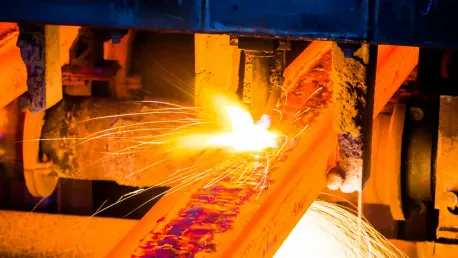The Italian steel industry stands at a critical juncture, grappling with a persistent economic downturn that has eroded profitability and tested the resilience of countless companies across the supply chain. Recent analyses reveal a sector battered by shrinking turnovers and mounting pressures from global competition, yet one that retains a glimmer of strength through solid equity and self-financing capabilities. With financial performance declining over recent years, industry leaders and analysts alike are sounding the alarm for urgent structural reforms. The challenges are multifaceted, ranging from internal fragmentation to external geopolitical uncertainties, making the path forward anything but straightforward. This deep dive explores the current state of the sector, the specific hurdles it faces, and the strategic imperatives needed to navigate an increasingly complex market landscape.
Economic Struggles and Financial Realities
Turnover and Profitability Plummet
The financial health of the Italian steel industry has taken a severe hit, with a reported 9.1% drop in turnover last year, translating to a staggering loss of 7 billion euros, bringing the total to 70.5 billion euros. Profits have also suffered, with EBITDA plummeting by 30% from 6.9 billion to 4.9 billion euros, while net profit fell from 3 billion to 2.1 billion euros. Added value, a key indicator of economic contribution, declined to 10.36 billion euros, reflecting the broader struggle to maintain viability amid reduced activity. Over a three-year span, the average turnover reduction stands at 12.1%, with EBITDA as a percentage of sales dropping by 4 percentage points. This decline is largely attributed to challenges in absorbing labor costs and a general slowdown in demand, painting a grim picture of an industry under siege from both internal inefficiencies and external market forces.
Bleak Outlook for the Near Future
Looking ahead, the outlook remains far from optimistic, with projections indicating that half of the surveyed companies anticipate further turnover declines in the coming year, while 45% expect reduced net profits, potentially leading to widespread losses. The inability to return to production levels seen just a few years ago suggests a structural shift in the industry’s landscape, one that may not easily reverse. Academic insights reinforce this concern, highlighting that the financial struggles witnessed recently are likely to intensify, with many firms at risk of operating at a loss. This pervasive uncertainty is compounded by the sector’s fragmented nature, which hampers the ability to respond cohesively to economic challenges. Without significant intervention, the risk of closures looms large, threatening not just individual companies but the broader ecosystem that relies on steel as a foundational material.
Strategic Imperatives for Recovery
The Case for Supply Chain Consolidation
Amid the economic turmoil, a consensus has emerged among industry leaders that consolidation within the supply chain is not just beneficial but essential for survival. The fragmentation of the sector, characterized by numerous small and medium-sized enterprises, has long been a barrier to achieving the critical mass needed to compete on a global scale. Strategic aggregation could enable companies to pool resources, streamline operations, and enhance bargaining power against international competitors. Industry voices argue that creating larger, more integrated entities would help mitigate the impact of fluctuating demand and rising costs, such as those driven by energy prices. Moreover, consolidation offers a pathway to share the burden of technological upgrades and regulatory compliance, both of which are increasingly pressing in the European context. The call for unified action underscores a recognition that isolated efforts are insufficient in a market defined by rapid change and intense competition.
Investing in Skills and External Growth
Beyond consolidation, there is a pressing need to invest in the future workforce and explore growth through external partnerships. Developing skills among younger generations is seen as a vital step to ensure the industry remains innovative and adaptable, particularly as technological transitions demand new expertise. Simultaneously, companies are urged to look beyond domestic borders for opportunities, leveraging foreign turnover to offset local market constraints. However, financial limitations pose a significant hurdle, as many firms lack the capital to pursue such expansive strategies. The desire for favorable investment conditions is palpable, with stakeholders advocating for policies that facilitate access to funding and reduce operational risks. Additionally, navigating external challenges like potential U.S. tariffs and disruptions in foreign demand requires a proactive stance, one that prioritizes strategic alliances and diversified revenue streams. These dual focuses on internal capability and external expansion represent a balanced approach to rebuilding competitiveness.
Reflections on a Path Forward
Building on Resilience Despite Setbacks
Reflecting on the past few years, the Italian steel industry has demonstrated a remarkable capacity to endure economic shocks, buoyed by strong equity indices and self-financing capabilities that aligned with broader European trends. Even as turnover and profits dwindled, the sector’s ability to absorb setbacks without collapsing entirely spoke to an underlying resilience. This foundation, though strained by a 30% profit reduction and a significant drop in added value, offered a sliver of hope amid the adversity. Industry analyses from that period emphasized how reduced debts and increased internal resources helped maintain relative stability, even as profitability took a nosedive. It became evident that while the challenges were severe, the structural solidity of many companies provided a potential springboard for recovery, provided the right strategies were implemented with urgency.
Charting a Course for Renewal
As the industry looks back on those struggles, the path ahead hinges on translating past resilience into actionable renewal. Consolidation must be prioritized to address fragmentation, enabling firms to achieve economies of scale and withstand global pressures. Equally critical is the push for innovation through workforce development and technological investment, ensuring the sector remains relevant in a fast-evolving landscape. Policymakers and industry leaders should collaborate to create an environment conducive to growth, easing financial constraints and mitigating risks from geopolitical uncertainties. By fostering strategic partnerships and exploring international markets, the sector can diversify its revenue base and reduce dependency on volatile domestic demand. These steps, grounded in the lessons of recent hardships, offer a roadmap to not just survive but thrive, ensuring that the Italian steel industry reclaims its competitive edge in the years to come.









